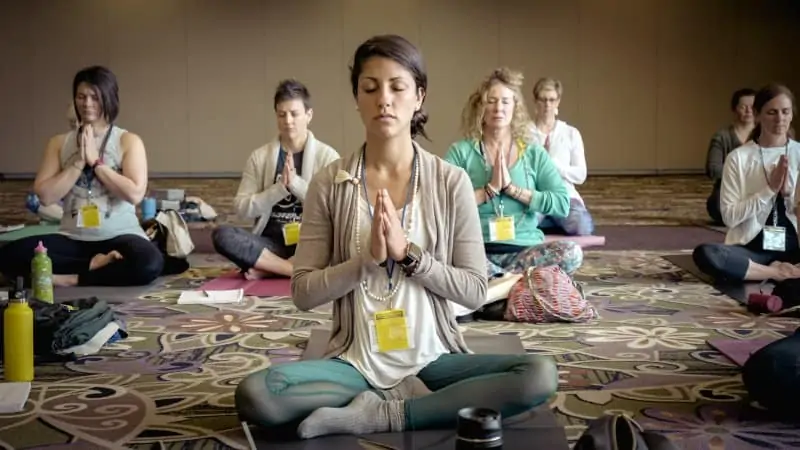Listen to this article:
An effortless natural meditation technique that doesn’t require disciplined focus, mind control, or any cult-like religious concepts? Umm, yes, please!
If meditation has always seemed a little woo-woo or difficult for you to concentrate on, you’re not alone. Despite all of its renowned benefits, most people can’t find time to meditate, and if they do, they’re often just frustrated by their wandering thoughts.
Most meditation techniques require focus, concentration, and a lot of self-discipline. Transcendental meditation is different because of its elegant simplicity and unique mantra-based technique.
Let’s dive into how to start your transcendental meditation practice and all the science-backed benefits you can enjoy from this ancient technique.
Contents
What is Transcendental Meditation?
Transcendental Meditation (TM) is a mantra-based meditation technique that can be practiced anywhere. It is designed to be completely effortless and relaxing. TM has been practiced for literally thousands of years and originated in the ancient Vedic teachings of India. It helps you reach a level of deep rest and inner peace.
Basically, you just sit comfortably with your eyes closed and silently repeat a mantra in your head for 20 minutes, twice per day. If you follow a simple transcendental meditation practice, you can reap tremendous science-backed benefits. It is also a perfect complement to your yoga practice.
Transcendental meditation was brought to the United States by Maharishi Mahesh Yogi in the 1960s, around the same time that yoga became very popular in the West. Celebrities ranging from The Beatles to Ellen Degeneres to Russell Brand have publicly praised the positive impacts of transcendental meditation on their lives.
Mantra-Based Meditation for Effortless Relaxation
The great thing about the TM technique is that it is uncomplicated and simple. You don’t have to fight your mind to be quiet or stop thinking altogether, nor do you have to subscribe to some intense spiritual visualization of your higher self. You don’t even need to be particularly concentrated or in control of the rate of your breath.
Instead, you just repeat the same silent phrase over and over. So simple!
What makes TM unique is that it is a mantra-based meditation rather than a visualization, breath work, or mindfulness meditation. Mantras have been used for millennia to help connect to the universe or a higher level of consciousness.
What are Transcendental Meditation Mantras?
A mantra is simply a word or phrase that is repeated over and over. It does not need to have religious or even spiritual implications. A mantra for TM can be assigned to you in a transcendental meditation course or you can find one online.
A TM mantra is often an ancient Sanskrit or Vedic word. But it can also be a word or phrase of your choice, depending on what you want to magnify into your life. A mantra helps you to transcend ordinary thoughts and move into a deeper state of perfect stillness of the mind. If your mind wanders, it is no big deal because you can just return to repeating the mantra.
When combined with deep breaths and consistency, the TM technique can result in increased happiness, reduced anxiety, more creativity, improved focus, lowered blood pressure, better sleep, more energy, and even better brain function and higher intelligence.
If it sounds too good to be true, just take a peak at some of the 600+ scientific research articles on transcendental meditation that have been conducted in recent years.
Science-Backed Benefits of Transcendental Meditation

While other meditation techniques and personal growth strategies rely on anecdotal stories of spiritual breakthroughs, transcendental meditation actually has over 600 scientific peer reviewed studies to back it up.
TM is one of the few meditation practices that has undergone the rigor of randomized controlled trials to demonstrate that literally anyone can do it and reap its benefits without subscribing to any religious or spiritual philosophy.
So what exactly are the benefits of transcendental meditation?
- Decreased stress
- Less anxiety
- Alleviation of symptoms of depression
- Reduced dependence on alcohol or tobacco
- Lowered cholesterol
- Lowered blood pressure
- Reduced risk of heart disease
- Improved cardiovascular health
- Better intellectual performance
- Improvement of ADHD symptoms (increased focus, less distraction)
I know, I know… it reads like a long sales pitch of the best drug ever invented, except there is no risk in practicing transcendental meditation and nothing to sell (unless you decide to take a one-time course from the TM non-profit described below).
Unlike pharmaceuticals and snake oil sales schemes, taking a few deep breaths and repeating a mantra never hurt anybody. In fact, the benefits for both physical and mental health have literally changed people’s lives.
Much like yoga, a transcendental meditation practice simply requires showing up for yourself on a daily basis.
Let’s dig into how exactly you can get started and whether or not you may want to sign up for a class to help kick off your TM practice.
Beginner’s Step-by-Step Guide to Transcendental Meditation

If you want to get started with meditation to manage stress or simply find a relaxing state in your day-to-day life, the transcendental meditation technique is incredibly minimalist.
But it’s more than just sitting quietly and trying not to think. TM practitioners use a specific mantra and sequence that is taught in the TM course. You can also follow this basic sequence to practice on your own:
- Find and Choose a Mantra
- Find a Quiet Space
- Set a Timer for 20 Minutes
- Sit and Breathe
- Repeat the Mantra
- Open Your Eyes
- Repeat Twice Per Day
Find or Choose a Mantra
Transcendental meditation begins with learning a mantra from a meditation teacher or choosing a mantra that feels right to you. The mantra should be based on your intention.
In a transcendental meditation course, a certified TM teacher assigns you a mantra. This mantra is supposed to be very sacred and personal to you, therefore they recommend keeping it a secret between only you and your teacher. The mantra that is assigned by a certified teacher comes from a lineage of mantras passed down over thousands of years. They will explain to you the importance of your mantra and how to use it properly for your desired results.
But remember, there are no rules for your meditation practice. Some practitioners insist that you need a specially taught transcendental mantra that has a vibrational resonance rather than a concrete verbal meaning. A great example is the primordial sound we often hear in yoga (Om).
On the other hand, some forms of meditation use mantras in English that do have real meanings, for example, a simple word like “abundance” or an affirmation such as “I am joyful”. Many practitioners choose their own mantra and change it every month or so depending on their needs.
Whichever camp you fall into, simply choose a word or phrase that speaks to your intention.
Find a Quiet Space
Once you have a mantra, you’re ready to start meditating. Transcendental meditation can be practiced literally anywhere thanks to its simplicity. All you need is a chair and your breath.
However, it makes it easier to meditate regularly when you have a quiet space set aside for your practice. This may be your yoga mat, a corner of your yoga room, or a special park bench. You may opt for incense, meditation candles, essential oils, and singing bowls to set the vibe and help you get into a relaxed mindset.
Regardless, ensure that nobody will bother you or disrupt your meditation for 15-20 minutes. Let your family or loved ones know that this time is for you.

Set a Timer for 20 Minutes
TM is traditionally practiced for exactly 20 minutes. While this may seem agonizingly long during your first session, many people find that their focused attention on the mantra eventually makes time fly by. Sometimes you will open your eyes and feel shocked that 20 minutes have already passed.
To experience the stress relief and pure consciousness from transcendental meditation, it’s best to opt for at least 15 minutes if possible, and no more than 20 minutes. Many TM teachers use a soft timer or some sort of singing bowl to signify the beginning and end of the meditation.
If you are practicing alone, a timer is the easiest way to make sure you don’t feel any stress about staying in a meditative state too long, nor an obligation to come out of the meditation early.
Sit and Breathe
Sit comfortably in your chair with your hands loosely on your lap and your spine in a straight, relaxed position. While meditation will definitely increase your deep sleep at night, most TM teachers recommend practicing transcendental meditation sitting up rather than lying down because you don’t want to fall asleep during the meditation itself.
Close your eyes and begin with a few deep pranayama breaths, then let your breathing return to a normal state for the duration of the practice. There is no need to control your breath or your thoughts. Simply keep your eyes closed for the full 20 minutes.
Repeat the Mantra
A common misconception is that mantras need to be chanted aloud the way you hear “OM” chanted in some yoga classes. In transcendental meditation, you should actually repeat the mantra silently only in your mind. Your lips do not move or whisper the mantra.
The ancient Sanskrit sound (or mantra of your choice) can be repeated in your mind at a calm, non-rushed pace. If you feel yourself getting distracted, simply return to repeating the mantra. You don’t have to do anything else.
While other forms of meditation may emphasize redirecting thoughts or ignoring them, TM does not place any emphasis on trying to silence your thoughts. As they come up, just let them flow by and return to the mantra.
Just keep silently repeating your mantra in your mind as you sit and breathe. You don’t have anything else to do.
Believe it or not, this is the path to transcendental consciousness.
If you have a certified TM teacher, you will receive a bit more energetic and communal support during your first few meditations so you can really hone in on the technique. You can also regularly access their help and advice free of charge after completing a course.
Open Your Eyes
When your timer is up, you can breathe deeply for a few more minutes or lightly flutter open your eyes to come out of the meditation. You can repeat the mantra one last time or simply close the meditation session with a smile, a bow, or “namaste”“.
Give yourself a bit of time to reflect and soak up the positive effects of the 20 minutes you just set aside for yourself. There should be no rush, nor any stress and anxiety about getting back to your to-do list.
I’ve found that, after transcendental meditation, I feel a profound sense of inner peace and deep calmness that few other practices provide. It is similar to the feeling you get after a challenging yoga class, except your body is completely relaxed and has not moved through any asanas.
Many people prefer to practice TM before or after yoga to help them feel especially grounded and focused on expanding their minds and quieting their mind’s internal conversations.
Repeat Twice Per Day
The TM technique is designed to be practiced twice per day, preferably in the morning and mid-afternoon. You don’t need to be particularly concentrated or try to achieve any certain state. You just need to set a timer for 20 minutes, close your eyes, and repeat the mantra.
It’s almost so easy that people want to make it more complicated than it needs to be. The best thing about the TM courses is that they give you the structure to just let loose and trust in the effortlessness of the practice.
After each meditation, you may feel blissful, grounded, clear, or inspired. You could also feel a little tired or confused. The experience varies amongst different people and may be different every day. No meditation practices are the same and that is perfectly OK.
TM is about accepting what is, not judging it or wanting it to be different.
Remember that there is no way to be “bad” at meditating. If you sit down, breathe, and repeat the mantra, you are practicing transcendental meditation and will eventually realize some of the benefits for yourself.
Do You Need to Take a TM Course?

As you can see, practicing transcendental meditation is remarkably simple. Anyone of any age could do it. Anyone can look up a mantra online and sit for 20 minutes repeating it.
However, there are also specially designed courses to help you establish a correct practice that may accelerate your results.
Whether or not you want to take a TM course is entirely up to you. Transcendental Meditation is actually a registered trademark owned by a non-profit educational organization called the Maharishi Foundation USA.
They offer courses throughout the United States and internationally. The course fee is based on a sliding income scale. All of the income from TM courses goes toward providing meditation support for at-risk children, veterans with PTSD, and other people in need.
Think of it like going to a yoga class or hiring a personal trainer: sure, you could do yoga or work out on your own, but the structure of a course allows you to learn the meditation technique directly from the people who created it and the process. You also get the built-in accountability of showing up for a four-day course and practicing the 20-minute meditations amongst a group.
Learning TM at a local center is an easy 3-part process:
- Go to a free introductory talk at a local transcendental meditation center to get an overview of the practice (or watch a recommend YouTube video series).
- Book for a paid one-on-one meditation class with a TM teacher (they will give you your mantra and guide you through your first session) *You may also be asked to bring a small fruit offering for the ceremony, but don’t worry, this isn’t any weird cult initiation or religious conversion, it’s just an ancient offering practice.
- Attend 3 group meditation sessions back-to-back to solidify your practice and help answer any of your questions.
The courses have been incredibly transformative in many peoples’ lives because it gives them the structure, discipline, and community experience of learning TM.
However, you can definitely practice TM without taking a course. There are no “gatekeepers” to the practice and definitely no cult initiation ceremony.
Is TM a Cult or Pyramid Scheme?
At first glance, some people think that transcendental meditation seems a little cult-like because of the initial ceremony and the fee-required courses. The benefits of transcendental meditation may sound “too good to be true” and come off as some sort of pyramid scheme. But then again, some people may think the same about yoga since it has spiritual underpinnings.
The reality is that transcendental meditation is not a cult or any sort of religious group nor a pyramid selling scheme. It is a meditation that anyone anywhere can practice. The man who brought the practice to the U.S. (Maharishi Mahesh Yogi) just happened to create a non-profit organization to help teach others and share the transformative effects of a regular TM practice.
Closing Thoughts
Whether you take the course or not, transcendental meditation mantras or the mantra-based form of meditating could be a rejuvenating way to find your center amidst the chaos of the world.
Namaste!
FAQs
How do I start transcendental meditation?
Starting transcendental meditation is as simple as taking a TM course or teaching yourself by finding a mantra, sitting in a quiet space, and focusing on repeating the mantra in your mind for 20 minutes at a time. The transcendental meditation technique is accessible to anyone anywhere, but transcendental meditation is definitely useful for clarifying exactly how to use your mantra and get the most out of your practice.
Can I learn TM on my own?
Anyone can learn or practice transcendental meditation with or without a course. There are plenty of online videos and guided TM meditations to help you learn. You can also use our Yoga Nomads step-by-step guide to transcendental meditation for beginners. There are many benefits to learning TM in a course, however the technique is universally available to anybody.
How are TM mantras chosen?
Most TM mantras are chosen by a certified TM teacher and given to a specific meditation student to keep private to themselves. However, you can also choose a mantra for yourself and there is no harm in creating your own TM mantra. The most important thing is to have a sound, word, or phrase that deeply resonates with you.


